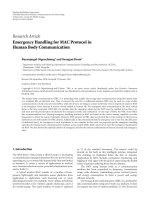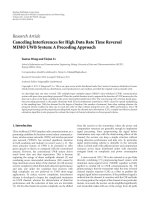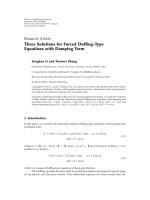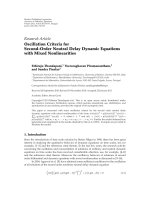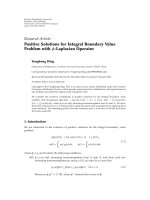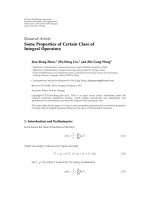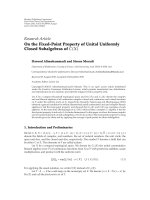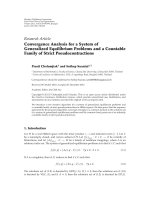Báo cáo hóa học: " Research Article Inclusion Properties for Certain Classes of Meromorphic Functions Associated with a Family of Linear Operators" pptx
Bạn đang xem bản rút gọn của tài liệu. Xem và tải ngay bản đầy đủ của tài liệu tại đây (504.81 KB, 12 trang )
Hindawi Publishing Corporation
Journal of Inequalities and Applications
Volume 2009, Article ID 147069, 12 pages
doi:10.1155/2009/147069
Research Article
Inclusion Properties for Certain Classes of
Meromorphic Functions Associated with a Family
of Linear Operators
Nak Eun Cho
Department of Applied Mathematics, Pukyong National University, Pusan 608-737, South Korea
Correspondence should be addressed to Nak Eun Cho,
Received 3 March 2009; Accepted 1 May 2009
Recommended by Ramm Mohapatra
The purpose of the present paper is to investigate some inclusion properties of certain classes of
meromorphic functions associated with a family of linear operators, which are defined by means
of the Hadamard product or convolution . Some invariant properties under convolution are also
considered for the classes presented here. The results presented here include several previous
known results as their special cases.
Copyright q 2009 Nak Eun Cho. This is an open access article distributed under the Creative
Commons Attribution License, which permits unrestricted use, distribution, and reproduction in
any medium, provided the original work is properly cited.
1. Introduction
Let A be the class of analytic functions in the open unit disk U
{z ∈ C : |z| < 1} with
the usual normalization f 0
f 0 − 1 0. If f and g are analytic in U, we say that f is
subordinate to g, written f ≺ g or f z ≺ g z , if there exists an analytic function w in U with
w 0
0 and |w z | < 1 for z ∈ U such that f z
g w z .
Let N be the class of all functions φ which are analytic and univalent in U and for
which φ U is convex with φ 0
1 and Re{φ z } > 0 for z ∈ U. We denote by S ∗ and K the
subclasses of A consisting of all analytic functions which are starlike and convex, respectively.
Let M denote the class of functions of the form
f z
1
z
∞
ak zk ,
1.1
k 0
which are analytic in the punctured open unit disk D U\{0}. For 0 ≤ η, β < 1, we denote by
MS η , MK η and MC η, β the subclasses of M consisting of all meromorphic functions
which are, respectively, starlike of order η, convex of order η and colse-to-convex of order β
and type η in U see, for details, 1, 2 .
2
Journal of Inequalities and Applications
Making use of the principle of subordination between analytic functions, we introduce
the subclasses MS η, φ , MK η, φ and MC η, β; φ, ψ of the class M for 0 ≤ η, β < 1 and
φ, ψ ∈ N, which are defined by
MS η; φ :
f ∈M:
zf z
1
−
−η
1−η
f z
MK η; φ :
f ∈M:
1
1−η
MC η, β; φ, ψ :
− 1
≺ φ z in U ,
zf z
f z
f ∈ M : ∃g ∈ MS η; φ s.t.
−η
≺ φ z in U ,
zf z
1
−
−β
1−β
g z
≺ ψ z in U .
1.2
We note that the classes mentioned above are the familiar classes which have been used
widely on the space of analytic and univalent functions in U see 3–5 and for special
choices for the functions φ and ψ involved in these definitions, we can obtain the well-known
subclasses of M. For examples, we have
MS η;
1 z
1−z
MS η ,
MK η;
1 z
1−z
MK η ,
MC η, β;
1 z 1 z
,
1−z 1−z
1.3
MC η, β .
Now we define the function φ a, c; z by
φ a, c; z :
1
z
∞
k 0
a
c
k 1
k 1
zk ,
1.4
z ∈ U; a ∈ R; c ∈ R \ Z− ; Z− : {−1, −2, . . .} ,
0
0
1.5
where ν k is the Pochhammer symbol or the shifted factorial defined in terms of the
Gamma function by
ν
k
:
Γν k
Γν
⎧
⎨1,
⎩ν ν
if k
1 ··· ν
k−1 ,
0, ν ∈ C \ {0},
if k ∈ N : {1, 2, . . .}, ν ∈ C.
1.6
Let f ∈ M. Denote by L a, c : M → M the operator defined by
L a, c f z
φ a, c; z ∗ f z
z∈D ,
1.7
where the symbol ∗ stands for the Hadamard product or convolution . The operator L a, c
was introduced and studied by Liu and Srivastava 6 . Further, we remark in passing that this
Journal of Inequalities and Applications
3
operator L a, c is closely related to the Carlson-Shaffer operator 7 defined on the space of
analytic and univalent functions in U.
Corresponding to the function φ a, c; z , let φ† a, c; z be defined such that
1
φ a, c; z ∗ φλ a, c; z
z 1−z
λ
λ>0 .
1.8
Analogous to L a, c , we now introduce a linear operator Lλ a, c on M as follows:
Lλ a, c f z c
φλ a, c; z ∗ f z ,
1.9
a, c ∈ R \ Z− ; λ > 0; z ∈ U; f ∈ M .
0
1.10
We note that
L1 2, 1 f z
f z ,
L1 1, 1 f z
zf z
2f z .
1.11
We note that the operator Lλ a, c is motivated essentially to the integral operator for analytic
functions defined by Choi et al. 3 , which extends the Noor integral operator studied by K.
I. Noor and M. A. Noor 8 also, see 9–13 .
Next, by using the operator Lλ a, c , we introduce the following classes of
meromprphic functions for φ, ψ ∈ N, a, c ∈ R \ Z− , λ > 0 and 0 ≤ η, β < 1:
0
MSλ η; φ :
a,c
f ∈ M : Lλ a, c f ∈ MS η; φ
,
λ
MKa,c η; φ :
f ∈ M : Lλ a, c f ∈ MK η; φ
,
λ
MCa,c η, β; φ, ψ :
f ∈ M : Lλ a, c f ∈ MC η, β; φ, ψ
1.12
.
We also note that
λ
f z ∈ MKa,c η; φ ⇐⇒ −zf z ∈ MSλ η; φ .
a,c
1.13
In particular, we set
MSλ η;
a,c
λ
MKa,c
λ
MKa,c
1 Az
1 Bz
1 Az
η;
1 Bz
MSλ η; A, B
a,c
−1 < B < A ≤ 1 ,
1.14
λ
MKa,c
η; A, B
−1 < B < A ≤ 1 .
In this paper, we investigate several inclusion properties of the classes MSλ η; φ ,
a,c
λ
η; φ , and MCa,c η; φ associated with the operator Lλ a, c defined by 1.9 .Some
4
Journal of Inequalities and Applications
invariant properties under convolution are also considered for the classes mentioned above.
Furthermore, relevant connections of the results presented here with those obtained in earlier
works are pointed out.
2. Inclusion Properties Involving the Operator Lλ a, c
The following lemmas will be required in our investigation.
Lemma 2.1. Let φλi a, c; z , φλ ai , c; z , and φλ a, ci ; z
λi > 0, ai , ci ∈ R \ Z− i 1, 2 ,
0
i
1, 2 be defined by 1.9 . Then for
φλ1 a, c; z
φλ2 a, c; z ∗fλ1 ,λ2 z ,
2.1
φλ a2 , c; z
φλ a1 , c; z ∗fa1 ,a2 z ,
2.2
φλ a, c1 ; z
φλ a, c2 ; z ∗fc1 ,c2 z ,
2.3
where
fs,t z
1
z
∞
s
t
k 0
k 1
k 1
zk
z∈D .
2.4
λ
1
zk
2.5
Proof. From 1.8 , we know that
φλ a, c; z
1
z
∞
k 0
c
a
k 1
k 1
k 1
k 1
z∈D .
Therefore 2.1 , 2.2 and 2.3 follow from 2.5 immediately.
Lemma 2.2 see 14, pages 60–61 . Let t ≥ s > 0. If t ≥ 2 or s
belongs to the class K, where fs,t is defined by 2.4 .
t ≥ 3, then the function z2 fs,t z
Lemma 2.3 see 15 . Let f ∈ K and g ∈ S∗ . Then for every analytic function h in U,
f∗hg U
f∗g U
⊂ coh U ,
2.6
where coh U denote the closed convex hull of h U .
λ
At first, the inclusion relationship involving the class MSa,c η; φ is contained in Theorem 2.4.
Theorem 2.4. Let λ2 ≥ λ1 > 0, a, c ∈ R \ Z− and φ ∈ N with Re{φ z } < 2 − η / 1 − η
0
1 . If λ2 ≥ 2 or λ1 λ2 ≥ 3, then
λ2
λ1
MSa,c η; φ ⊂ MSa,c η; φ .
0≤η<
2.7
Journal of Inequalities and Applications
5
λ2
λ2
Proof. Let f ∈ MSa,c η; φ . From the definition of MSa,c η; φ , we have
1
1−η
−
z Lλ2 a, c f z
Lλ2 a, c f z
z z2 Lλ2 a, c f z
z2 Lλ2 a, c f z
−η
φ w z
2− 1−η φ w z
−η ≺
where w is analytic in U with |w z | < 1 z ∈ U and w 0
and 2.8 , we get
0
z∈U ,
1 z
1−z
z Lλ1 a, c f z
Lλ1 a, c f z
2.9
φ 0 − 1. By using 1.9 , 2.1
−
z φλ1 a, c; z ∗ f z
φλ1 a, c; z ∗ f z
−
−
z∈U ,
2.8
z φλ2 a, c; z ∗ fλ1 ,λ2 z ∗ f z
φλ2 a, c; z ∗ fλ1 ,λ2 z ∗ f z
2.10
fλ1 ,λ2 z ∗ −z Lλ2 a, c f z
fλ1 ,λ2 z ∗ Lλ2 a, c f z
fλ1 ,λ2 z ∗
1−η φ w z
η Lλ2 a, c f z
.
fλ1 ,λ2 z ∗ Lλ2 a, c f z
Therefore by using 2.8 , we obtain
1
1−η
−
z Lλ1 a, c f z
Lλ1 a, c f z
−η
1
1−η
fλ1 ,λ2 z ∗
1−η φ w z
η Lλ2 a, c f z
−η
fλ1 ,λ2 z ∗ Lλ2 a, c f z
1
1−η
η z2 Lλ2 a, c f z
z2 fλ1 ,λ2 z ∗ 1 − η φ w z
−η .
2f
2L
z λ1 ,λ2 z ∗ z λ2 a, c f z
2.11
It follows from 2.9 and Lemma 2.2 that z2 Lλ2 a, c f z ∈ S∗ and z2 fλ1 ,λ2 ∈ K, respectively.
Let us put s w z : 1 − η φ w z
η. Then by applying Lemma 2.3 to 2.10 , we obtain
z2 fλ1 ,λ2 ∗ s w z z2 Lλ2 a, c f
z2 fλ1 ,λ2 ∗ z2 Lλ2 a, c f
U ⊂ cos w U
⊂s U ,
2.12
6
Journal of Inequalities and Applications
since s is convex univalent. Therefore from the definition of subordination and 2.12 , we
have
1
1−η
−
z Lλ1 a, c f z
Lλ1 a, c f z
−η
≺φ z
z∈U ,
2.13
λ1
or, equivalently, f ∈ MSa,c φ , which completes the proof of Theorem 2.4.
By using 1.13 , 2.2 and 2.3 , we have the following Theorem 2.5 and Theorem 2.6.
Theorem 2.5. Let λ > 0, a2 ≥ a1 > 0, c ∈ R \ Z− and φ ∈ N with Re{φ z } < 2 − η / 1 − η
0
η < 1 . If a2 ≥ 2 or a1 a2 ≥ 3, then
λ
λ
MSa1 ,c η; φ ⊂ MSa2 ,c η; φ .
0≤
2.14
Theorem 2.6. Let λ > 0, a ∈ R \ Z− , c2 ≥ c1 > 0 and φ ∈ N with Re{φ z } < 2 − η / 1 − η
0
η < 1 . If c2 ≥ 2 or c1 c2 ≥ 3, then
λ
λ
MSa,c2 η; φ ⊂ MSa,c1 η; φ .
0≤
2.15
Next, we prove the inclusion theorem involving the class MKλ η; φ .
a,c
Theorem 2.7. Let λ2 ≥ λ1 > 0, a, c ∈ R \ Z− and φ ∈ N with Re{φ z } < 2 − η / 1 − η
0
1 . If λ2 ≥ 2 or λ1 λ2 ≥ 3, then
MKλ2 η; φ ⊂ MKλ1 η; φ .
a,c
a,c
0≤η<
2.16
Proof. Applying 1.13 and Theorem 2.4, we observe that
f z ∈ MKλ2 η; φ ⇐⇒ Lλ2 a, c f z ∈ MK η; φ
a,c
⇐⇒ −z Lλ2 a, c f z
∈ MS η; φ
⇐⇒ Lλ2 a, c −zf z
∈ MS η; φ
λ2
⇐⇒ −zf z ∈ MSa,c η; φ
λ1
⇒ −zf z ∈ MSa,c η; φ
⇐⇒ Lλ1 a, c −zf z
∈ MS η; φ
⇐⇒ −z Lλ1 a, c f z
∈ MS η; φ
⇐⇒ Lλ1 a, c f z ∈ MK η; φ
⇐⇒ f z ∈ MKλ1 η; φ ,
a,c
which evidently proves Theorem 2.7.
2.17
Journal of Inequalities and Applications
7
By using a similar method as in the proof of Theorem 2.7, we obtain the following two
theorems.
Theorem 2.8. Let λ > 0, a2 ≥ a1 > 0, c ∈ R \ Z− and φ ∈ N with Re{φ z } < 2 − η / 1 − η
0
η < 1 . If a2 ≥ 2 or a1 a2 ≥ 3, then
MKλ1 ,c η; φ ⊂ MKλ2 ,c η; φ .
a
a
2.18
Theorem 2.9. Let λ > 0, a ∈ R \ Z− , c2 ≥ c1 > 0 and φ ∈ N with Re{φ z } < 2 − η / 1 − η
0
η < 1 . If c2 ≥ 2 or c1 c2 ≥ 3, then
MKλ 2 η; φ ⊂ MKλ 1 η; φ .
a,c
a,c
Taking φ z
1 Az / 1
the following corollaries below.
Bz
0≤
0≤
2.19
−1 < B < A ≤ 1; z ∈ U in Theorems 2.4–2.9, we have
Corollary 2.10. Let 1 A 1 − η < 2 − η 1 B −1 < B < A ≤ 1; 0 ≤ η < 1 and c ∈ R \ Z− .
0
If λ2 ≥ λ1 > 0 and λ2 ≥ min{2, 3 − λ1 }, and a2 ≥ a1 > 0 and a2 ≥ min{2, 3 − a1 }, then
λ2
λ1
λ1
MSa1 ,c η; A, B ⊂ MSa1 ,c η; A, B ⊂ MSa2 ,c η; A, B ,
MKλ2 ,c η; A, B ⊂ MKλ1 ,c η; A, B ⊂ MKλ1 ,c η; A, B .
a1
a1
a2
2.20
Corollary 2.11. Let 1 A 1 − η < 2 − η 1 B −1 < B < A ≤ 1; 0 ≤ η < 1 and λ > 0. If
a2 ≥ a1 > 0 and a2 ≥ min{2, 3 − a1 }, and c2 ≥ c1 > 0 and c2 ≥ min{2, 3 − c1 }, then
λ
λ
λ
MSa1 ,c2 η; A, B ⊂ MSa1 ,c1 η; A, B ⊂ MSa2 ,c1 η; A, B ,
MKλ1 ,c2
a
η; A, B ⊂
MKλ1 ,c1
a
MKλ2 ,c1
a
η; A, B ⊂
2.21
η; A, B .
Corollary 2.12. Let 1 A 1 − η < 2 − η 1 B −1 < B < A ≤ 1; 0 ≤ η < 1 and a ∈ R \ Z− .
0
If λ2 ≥ λ1 > 0 and λ2 ≥ min{2, 3 − λ1 }, and c2 ≥ c1 > 0 and c2 ≥ min{2, 3 − c1 }, then
λ2
λ2
λ1
MSa,c2 η; A, B ⊂ MSa,c1 η; A, B ⊂ MSa,c1 η; A, B ,
MKλ2 2 η; A, B ⊂ MKλ2 1 η; A, B ⊂ MKλ1 1 η; A, B .
a,c
a,c
a,c
2.22
To prove theorems below, we need the following lemma.
Lemma 2.13. Let φ ∈ N with Re{φ z } < 2 − η / 1 − η
and q ∈ MS η; φ , then f ∗ q ∈ MS η; φ .
0 ≤ η < 1 . If f ∈ M with z2 f z ∈ K
8
Journal of Inequalities and Applications
Proof. Let q ∈ MS η; φ . Then
−zq z
1−η φ w z
η q z
where w is an analytic function in U with |w z | < 1
1
1−η
−
z f z ∗q z
f z ∗q z
z∈U ,
2.23
z ∈ U and w 0
0. Thus we have
−η
1
1−η
f z ∗ −zq z
f z ∗q z
1
1−η
f z ∗
−η
1−η φ ω z
f z ∗q z
2.24
η q z
−η
z∈D .
By using the similar arguments to those used in the proof of Theorem 2.4, we conclude that
2.24 is subordinated to φ in U and so f ∗ q ∈ MS η; φ .
Finally, we give the inclusion properties involving the class MCλ η, β; φ, ψ .
a,c
Theorem 2.14. Let c ∈ R \ Z− and φ, ψ ∈ N with Re{φ z } < 2 − η / 1 − η 0 ≤ η < 1 . If
0
λ2 ≥ λ1 > 0 and λ2 ≥ min{2, 3 − λ1 }, and a2 ≥ a1 > 0 and a2 ≥ min{2, 3 − a1 }, then
MCλ2 ,c η, β; φ, ψ ⊂ MCλ1 ,c η, β; φ, ψ ⊂ MCλ1 ,c η, β; φ, ψ .
a1
a1
a2
2.25
Proof. We begin by proving that
MCλ2 ,c η, β; φ, ψ ⊂ MCλ1 ,c η, β; φ, ψ .
a1
a1
2.26
Let f ∈ MCλ2 ,c η, β; φ, ψ . Then there exists a function q2 ∈ MS η; φ such that
a1
1
1−β
−
z Lλ2 a1 , c f z
q2 z
−β
≺ψ z
0 ≤ β < 1; z ∈ U .
2.27
From 2.27 , we obtain
−z Lλ2 a1 , c f z
1−β ψ w z
β q2 z ,
2.28
Journal of Inequalities and Applications
9
where w is an analytic function in U with |w z | < 1 z ∈ U and w 0
0. By virtue of 2.3 ,
Lemmas 2.2 and 2.13, we see that fλ1 ,λ2 z ∗ q2 z ≡ q1 z belongs to MS η; φ . Then, making
use of 2.1 , we have
1
1−β
z Lλ1 a1 , c f z
−β
q1 z
⎛
1 ⎜ fλ1 ,λ2 z ∗ −z Lλ2 a1 , c f z
⎝
1−β
fλ1 ,λ2 z ∗ q2 z
−
⎟
− β⎠
β q2 z
2.29
1
1−β
fλ1 ,λ2 z ∗
1
1−β
β z2 q2 z
z2 fλ1 ,λ2 z ∗ 1 − β ψ w z
−β
z2 fλ1 ,λ2 z ∗ z2 q2 z
≺ψ z
1−β ψ w z
fλ1 ,λ2 z ∗ q2 z
⎞
−β
z∈U .
Therefore we prove that f ∈ MCλ1 ,c η, β; φ, ψ .
a1
For the second part, by using arguments similar to those detailed above with 2.2 , we
obtain
MCλ1 ,c η, β; φ, ψ ⊂ MCλ1 ,c η, β; φ, ψ
a1
a2
2.30
Thus the proof of Theorem 2.14 is completed.
The following results can be obtained by using the same techniques as in the proof of
Theorem 2.14 and so we omit the detailed proofs involved.
Theorem 2.15. Let λ > 0 and φ, ψ ∈ N with Re{φ z } < 2−η / 1−η
and a2 ≥ min{2, 3 − a1 }, and c2 ≥ c1 > 0 and c2 ≥ min{2, 3 − c1 }, then
0 ≤ η < 1 . If a2 ≥ a1 > 0
MCλ1 ,c2 η, β; φ, ψ ⊂ MCλ1 ,c1 η, β; φ, ψ ⊂ MCλ2 ,c1 η, β; φ, ψ .
a
a
a
2.31
Theorem 2.16. Let a ∈ R \ Z− and φ, ψ ∈ N with Re{φ z } < 2 − η / 1 − η 0 ≤ η < 1 . If
0
λ2 ≥ λ1 > 0 and λ2 ≥ min{2, 3 − λ1 }, and c2 ≥ c1 > 0 and c2 ≥ min{2, 3 − c1 }, then
MCλ2 2 η, β; φ, ψ ⊂ MCλ2 1 η, β; φ, ψ ⊂ MCλ1 1 η, β; φ, ψ .
a,c
a,c
a,c
2.32
Remark 2.17. For a λ 1 λ > −1 and c 1, Theorems 2.4, 2.5, 2.7, 2.8, and 2.14 reduce to
the corresponding results obtained by Cho and Noor 16 .
3. Inclusion Properties Involving Various Operators
λ
The next theorem shows that the classes MSa,c η; φ , MKλ η; φ and MCλ η, β; φ, ψ are
a,c
a,c
invariant under convolution with convex functions.
10
Journal of Inequalities and Applications
Theorem 3.1. Let λ > 0, a > 0, c ∈ R \ Z− , φ, ψ ∈ N with Re{φ z } < 2 − η / 1 − η
0
and let g ∈ M with z2 g z ∈ K. Then
0≤η<1
λ
λ
i f ∈ MSa,c η; φ ⇒ g∗f ∈ MSa,c η; φ ,
ii f ∈ MKλ η; φ ⇒ g∗f ∈ MKλ η; φ ,
a,c
a,c
iii f ∈ MCλ η, β; φ, ψ ⇒ g∗f ∈ MCλ η, β; φ, ψ .
a,c
a,c
λ
Proof. i Let f ∈ MSa,c η; φ . Then we have
⎛
1
1−η
−
z Lλ a, c g ∗ f z
1 ⎜
⎝
1−η
−η
Lλ a, c g ∗ f z
g z ∗ −z Lλ a, c f z
g z ∗ Lλ a, c f z
⎞
⎟
− η⎠.
3.1
By using the same techniques as in the proof of Theorem 2.4, we obtain i .
ii Let f ∈ MKλ φ . Then, by 1.13 , −zf z ∈ MSa,c η; φ and hence from i ,
a,c
λ
g z ∗ −zf z ∈ MSa,c η; φ . Since
g z ∗ −zf z
−z g ∗ f
z ,
3.2
we have ii applying 1.13 once again.
iii Let f ∈ MCλ η, β; φ, ψ . Then there exists a function q ∈ MS η; φ such that
a,c
−z Lλ a, c f z
1−β ψ w z
β q z
where w is an analytic function in U with |w z | < 1
we have that g ∗ q ∈ MS η; φ . Since
1
1−β
−
z Lλ a, c g ∗ f z
g∗q z
⎛
1 ⎜
⎝
1−β
1
1−β
≺ψ z
we obtain iii .
z ∈ U and w 0
g z ∗q z
z∈U ,
3.3
0. From Lemma 2.13,
−β
g z ∗ −z Lλ a, c f z
z2 g z ∗
0 ≤ β < 1; z ∈ U ,
1−β ψ w z
z2 g z ∗ z2 q z
⎞
⎟
− β⎠
β z2 q z
3.4
−β
Journal of Inequalities and Applications
11
Now we consider the following operators defined by
Ψ1 z
Ψ2 z
1 ∞ 1
zk 1k
c k−1
z
c
1 − xz
1
log
2 1−x
1−z
z
Re{c} ≥ 0; z ∈ D ,
3.5
log 1
0; |x| ≤ 1, x / 1; z ∈ D .
It is well known 17 that the operators z2 Ψ1 and z2 Ψ2 are convex univalent in U. Therefore
we have the following result, which can be obtained from Theorem 3.1 immediately.
Corollary 3.2. Let a > 0, λ > 0, c ∈ R \ Z− , φ, ψ ∈ N with Re{φ z } < 2 − η / 1 − η
0
and let Ψi i 1, 2 be defined by 3.5 , respectively. Then
0≤η<1
λ
λ
i f ∈ MSa,c η; φ ⇒ Ψi ∗f ∈ MSa,c η; φ ,
ii f ∈ MKλ η; φ ⇒ Ψi ∗f ∈ MKλ η; φ ,
a,c
a,c
iii f ∈ MCλ η, β; φ, ψ ⇒ Ψi ∗f ∈ MCλ η, β; φ, ψ .
a,c
a,c
Acknowledgments
The author would like to express his gratitude to the referees for many valuable advices
regarding a previous version of this paper. This work was supported by the Korea Research
Foundation Grant funded by the Korean Government MOEHRD, Basic Research Promotion
Fund KRF-2008-313-C00035 .
References
1 V. Kumar and S. L. Shukla, “Certain integrals for classes of p-valent meromorphic functions,” Bulletin
of the Australian Mathematical Society, vol. 25, no. 1, pp. 85–97, 1982.
2 S. S. Miller and P. T. Mocanu, Differential Subordinations, vol. 225 of Monographs and Textbooks in Pure
and Applied Mathematics, Marcel Dekker, New York, NY, USA, 2000.
3 J. H. Choi, M. Saigo, and H. M. Srivastava, “Some inclusion properties of a certain family of integral
operators,” Journal of Mathematical Analysis and Applications, vol. 276, no. 1, pp. 432–445, 2002.
4 Y. C. Kim, J. H. Choi, and T. Sugawa, “Coefficient bounds and convolution properties for certain
classes of close-to-convex functions,” Proceedings of the Japan Academy, Series A, vol. 76, no. 6, pp. 95–
98, 2000.
5 W. C. Ma and D. Minda, “An internal geometric characterization of strongly starlike functions,”
Annales Universitatis Mariae Curie-Skłodowska. Sectio A, vol. 45, pp. 89–97, 1991.
6 J.-L. Liu and H. M. Srivastava, “A linear operator and associated families of meromorphically
multivalent functions,” Journal of Mathematical Analysis and Applications, vol. 259, no. 2, pp. 566–581,
2001.
7 B. C. Carlson and D. B. Shaffer, “Starlike and prestarlike hypergeometric functions,” SIAM Journal on
Mathematical Analysis, vol. 15, no. 4, pp. 737–745, 1984.
8 K. I. Noor and M. A. Noor, “On integral operators,” Journal of Mathematical Analysis and Applications,
vol. 238, no. 2, pp. 341–352, 1999.
9 J.-L. Liu, “The Noor integral and strongly starlike functions,” Journal of Mathematical Analysis and
Applications, vol. 261, no. 2, pp. 441–447, 2001.
10 J.-L. Liu and K. I. Noor, “Some properties of Noor integral operator,” Journal of Natural Geometry, vol.
21, no. 1-2, pp. 81–90, 2002.
11 K. I. Noor, “On new classes of integral operators,” Journal of Natural Geometry, vol. 16, no. 1-2, pp.
71–80, 1999.
12
Journal of Inequalities and Applications
12 K. I. Noor, “Some classes of p-valent analytic functions defined by certain integral operator,” Applied
Mathematics and Computation, vol. 157, no. 3, pp. 835–840, 2004.
13 K. I. Noor and M. A. Noor, “On certain classes of analytic functions defined by Noor integral
operator,” Journal of Mathematical Analysis and Applications, vol. 281, no. 1, pp. 244–252, 2003.
14 St. Ruscheweyh, Convolutions in Geometric Function Theory, vol. 83 of S´ minaire de Math´ matiques
e
e
Sup´ rieures, Presses de l’Universit´ de Montr´ al, Montreal, Canada, 1982.
e
e
e
15 St. Ruscheweyh and T. Sheil-Small, “Hadamard products of schlicht functions and the Polya´
Schoenberg conjecture,” Commentarii Mathematici Helvetici, vol. 48, pp. 119–135, 1973.
16 N. E. Cho and K. I. Noor, “Inclusion properties for certain classes of meromorphic functions associated
with the Choi-Saigo-Srivastava operator,” Journal of Mathematical Analysis and Applications, vol. 320,
no. 2, pp. 779–786, 2006.
17 R. W. Barnard and Ch. Kellogg, “Applications of convolution operators to problems in univalent
function theory,” The Michigan Mathematical Journal, vol. 27, no. 1, pp. 81–94, 1980.

